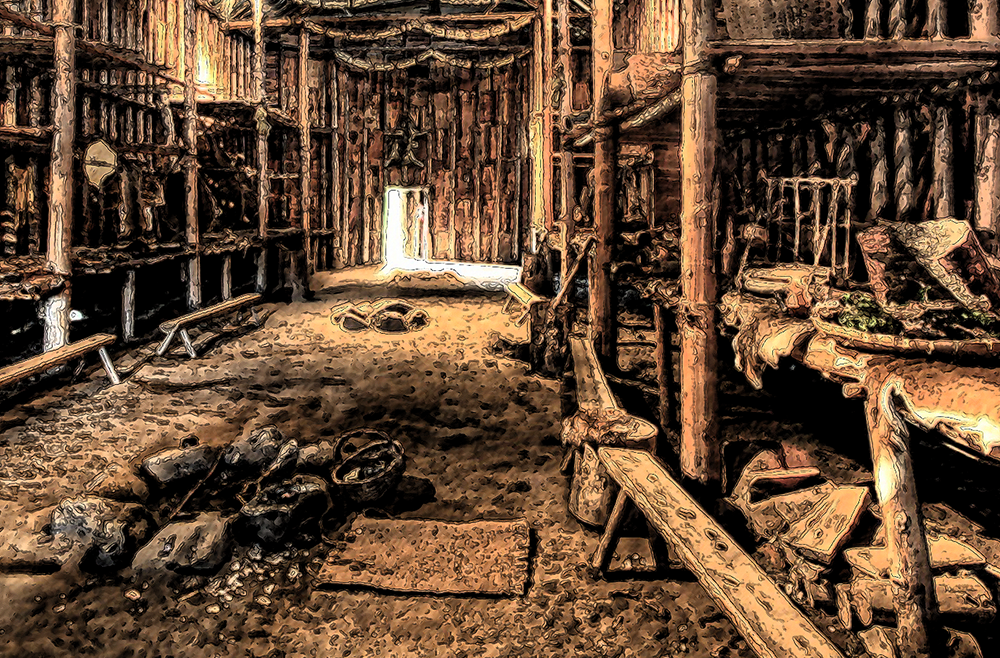
The Rhythm of the Sun
In the time before the pale ones, from a far away place where the sun awakes, came to our lands – when our world changed forever – we had in our culture, times and places for all things. The sun and the moon were then, as always, our guides for living each season.
They gave meaning to our daily lives and defined when we planted and when we had harvest. Their paths across Grandfather Sky determined when to hold ceremonies. These were our benchmarks, the calendar and clock for our people.
Of great importance was our following the cycles of the sun. The two most important days were Ni’ibin, the longest day where the sun was in the sky the most, and Zi’igwan, the shortest day where the sun left much too soon. These were the two pivotal markers of our year. At these times the Medicine People performed great ceremonies to honor the warm month gift of Kizis (the sun) – the Great Fire in the sky… and pray on evening of Zi’igwan, that Kizis would return again, as it had since the time told in that the stories of First Parents.
Also of great significance were the middle times, when day and night were equal. Min’o-okamin – where the time of new growth, and day and night were the same, and at harvest time Da’gwaa-gin, when day and night were again the same. These were important times for us, for us to recall the old stories, to honor our Creator for these gifts, and important that we understood that these gifts or markers told us what was to come, and reminded us of what had passed.
…the center fire flickered and danced shadows upon the walls of the Lodge. In this place even the occasional grumpy old uncle was happy. All was good, for always things were in Balance.
In the time after the harvest, the fish and meat were dried, and the winter greens and fruits likewise. The Three Sisters, corn, beans and squash were stored in great baskets in cool dark places in the lodge. All this was done that our people would be prepared for the long nights and bitter cold, in the time of hunger and the passing of elders. In the shortening hours of daylight the people would hunt, gather nuts and greens that still lay in the open areas, taking only a third. For the rest belonged to the Animal People and for reseeding. This was our way.
By the light of the center fire in the lodge, clothing and tools were made from leather, wood and flint, and pemican from dried meat, fat, nuts and berries. As these evening chores were being done, the Elders shared teaching stories and told great happenings of their youth, all in times long past. This was the time of recollection and the prayers, and a time of the long Cold Sleep.*
For people today this seems like a terrible way to live, but for our Mide’/Shawnee ancestors, just like your ancestors (for they lived in a similar manner), it was simply the time to rest until longer days came once again.
Within the lodge there existed a microcosm of the Tribal world of that day. Most important were the people who lived there, the Elders, parents, young adults and children, yes all lived in the same place. The lodge was not very large, rather like a loaf shaped basket turned upside down. A family Lodge was perhaps six or eight arms lengths long and two or three in width. An arms spread in that time was about five feet. Inside this “basket” the height reached eight or ten feet. On either side of the center area, which was kept clear and compacted hard by the continual stepping of bare feet, were poles reaching to the top. Suspended from these polls along the walls were shelves, for bunk-like beds and places to store the food and necessities for the people therein.
The walls of the Lodge were made of long saplings inserted in the ground, bent and tied together at the top. Horizontal saplings were tied to these to make it rigid. The exterior was covered with animal hides and then with sheets of bark, laced to the framework like shingles on a roof. This was very waterproof. The interior walls were lined with woven mats and animal skins held in place with long branches tied to the upright saplings. Between the inner and outer wall were stuffed all form of soft materials, leaves, grasses, cattail fluff and other natural materials to insulate the walls. Thick barriers against the cold winters of our homelands. In that time, these lodges were warmer and better insulated than most log, timber framed, and stone houses in European lands.
The relationship between the Elders and the children was strong, warm and loving. The Elders shared their stories and taught the children skills needed for everyday life. The children cared for the Elders, bringing them food and drink and making sure they’re comfortable. The parents and the young adults would tend to the hunting, gathering and caring for the crops grown in the warm months. Throughout the year everyone, the Elders, children, parents and young adults would gather firewood for the winter.
The adults and children were naturally closely attuned to each other’s thoughts and feelings, but most importantly there was respect for the Elders, for they were the source of all knowledge and wisdom. In the evening before they would retire, stories were told and songs sung… as the center fire flickered and danced shadows upon the walls of the Lodge. In this place even the occasional grumpy old uncle was happy. All was good, for always things were in Balance.
The Traditional Circle of Connection
Many days before Zi’igwan day, the adults went about gathering twigs stones, leather, feathers and other small items, placing them in a bundle, of hide wrapped around the items and tied together with twisted fiber string or leather strap.
Early in the morning of Zi’igwan, as the muffled sounds of the sleeping adults softly filled the lodge, the older children quietly aroused to prepare for this special day. Bundled in heavy fur robes, as the temperature inside had dropped to around 40°F, they kindled the fire, as was the custom. The lodge soon warmed to a toasty winter comfort of the mid 50s. This was the customary temperature inside a lodge in the wintertime, where our people, the Panjii Seepe Naube, the Blue Creek People, had always lived, since before time. This was the place of The Ancestors where their dust is part of Tula, our Grandmother, the earth itself.
The older children went about waking the youngest, who had not yet slipped from the warmth of their bear fur covers. By this time the Elders and adults were also awake. But they lay quietly, as if still asleep, for this is the time of the children.
Quietly and quickly the children dressed and searched lodge for the bundles that had been carefully prepared, hidden in and amongst the belongings. Soft giggles and whispers passed back-and-forth as the children would discover a bundle and share what they had found. Now the young adults gathered with the young to help them in their traditional tasks. For having found these gifts, it now was their responsibility to make gifts for the Elders.
This was an important time, for traditional tells us that at this time the Veil that separates the living from the dead is thinnest.
As they set about making their creations, the lodge came alive, the women stoked the fires, for cooking. Soon the lodge became a beehive of activity. Each child with their mentors went about creating the very best gift they could conceive, made of the bits and pieces the elders had placed in the bundles. The excitement was kin to opening the presents on Christmas day in modern homes.
As the day grew on, the gifts were finished and respectively, with great honor, presented to each Elder. The gifts created were not a mishmash , but functional and useful gifts for the Elders. Bags to store things. Handled knives of flint for their use, gloves or moccasin slippers, or hats of warm furs were presented. The circle was complete. The Elders had taught the children of the ways of their People, of survival, of planting and hunting, of the Sky and Earth, and the seasons… and most importantly the oral tradition of their history, that the record of the People would not die. In return the children used those learned skills and the bits in the bundles to make the gifts that they presented to the Elders.
In the evening there was a great Feast for the Dead that was enjoyed by all. Later in the evening of this shortest day, the family gathered around the fire in the lodge and listening to the Elders tell the stories of old times, of family and friends that had passed through the Veil.
This was an important time, for traditional tells us that at this time the Veil that separates the living from the dead is thinnest. After they had finished telling the stories, each person in turn, both young and old spoke of those they missed who are no longer with them. As each began to share their thoughts about who they missed, they would face the outer wall of the lodge and call their name out loud, turning back towards the fire, would call the name again, softly. As each person went around the circle, by their actions and their words they invited those who were listening on the other side of the Veil to join them in this quiet evening.
Then braving the cold, they took bits of food carefully saved from the feast and went outside to the center of the village, to the Great House Lodge. There they placed the food at the altar. One last time called out the name of each person they missed, four times. To the east, to the south, to the west, to the north. In a loud and caring voice, they twice called out the word… Weee’loooh, Weee’loooh! This is the traditional cry used to call to someone who is lost in the woods, or are needed in the village. This last action was not so much to call in those gone at this time, but to let them know that they are missed and that those there wished they were home, safe in the lodge this night.
Returning to their lodge, the fire was banked for the night and they slipped into their beds, bundled in furs against cold. Last prayers and goodnights uttered, they slumbered into dreams, often filled with memories of the deceased, for indeed, the Veil was thinnest that night.
This is the way of Zi’igwan, The Shortest Day, that we celebrate to this day.
Post note:
Before there were the traditional holidays that we celebrate around the world today, with all their religious practices… there were the traditions of our ancient ancestors. Around the fires in their caves and the first villages, the Ancestors’ practice of observing the seasons and their connection to Grandfather Sky, and the sun and the moon and Grandmother Tula, the Earth were observed. The winter and summer solstice and the spring and fall equinox were the pivotal events celebrated by our First parents… who sat around the first fires… and begin the first traditions.
This is a tradition of our People, the Mide’/Shawnee that has been passed down through the millennia, and practiced yet today. We hope you enjoyed this sharing, and humbly ask that you consider how your life may be changed by adapting to this tradition for your family.
Megwiich!
*Cold Sleep: The time when the old with frailties, and the infants that could not survive died.
